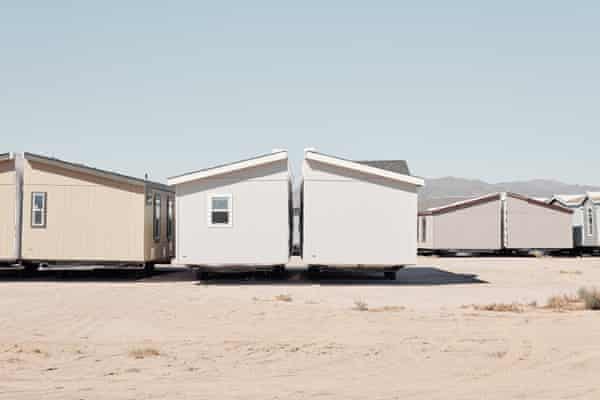Perhaps the most “crazy” of the ideas is the one that would involve building a desalination plant in the Mexican town of Puerto Peñasco, perched on the edge of the Gulf of California, to suck up seawater and then send the treated water in a pipeline several hundred miles north to Arizona. Much of the pipeline’s proposed route is uphill and will traverse an international border,
a federally protected area famed for its cactus and several small towns.
A new housing development in northern Buckeye. Photograph: Adam Riding/The Guardian
Environmentalists have already criticized the plan for its potential ecological impact upon both land and sea – the salty brine left over would be dumped back into the Gulf of California, altering its composition and potentially harming its marine life. The odds may be against the pipeline, given the cost and opposition. But
IDE, the Israeli company that proposed the $5bn plan, has said the pipeline would be “transformative” for Arizona, would provide enough water for the entire state and “secure Arizona’s future growth”.
Arizona’s
Water Infrastructure Finance Authority (or Wifa), the agency tasked with implementing a new inflow of water to the state, is assessing the Mexico idea, as well as other options. Chuck Podolak, director of the agency, has his own office map that helps him envision other possible stupendous infrastructure undertakings, such as a pipeline running from another desal plant, in California, or a pipeline that could convey water from the distant Missouri River to the thirsty desert.
“Those are big, audacious ideas, but I don’t think any are off the table,” said Podolak. “We’re going to seek the wild ideas and fund the good ones.”
Podolak acknowledged any pipeline from Mexico will face numerous hurdles – Wifa has been in touch with lawmakers in Mexico, some of whom are unfavorable to the idea – but insisted Arizona will continue to push for a new, leviathan project to make up its water shortfall.
“I just want to see multiple projects and figure out the best one for us. If we want to have that long-term security, we do need a new bucket, so to speak, a new source of supply outside of the state. This is a fantastic place to live.”
Podolak points out such big ideas are in keeping with previous monumental, and seemingly impossible, projects. “We dammed up the Colorado River and built the Hoover Dam, we have an artificial river that runs from Lake Havasu to Tucson uphill 300 miles – it’s called the
Central Arizona Project,” he said.
“All these things seemed audacious, but now they’re part of the landscape. We’ve been doing it for 100 years.”
Such grandiose plans are being mulled because Arizona faces pressures like never before. The state has been in the teeth of a drought, spurred by global heating, that is the worst the US south-west
has seen in approximately 1,200 years.
About a third of the state’s water supply comes from the Colorado River, which has
shrunk as temperatures have risen. Last year, under a mechanism where Arizona shares water with other states, its allotment of Colorado River water
was cutby 21%.
Arizona’s other major water source – from underground aquifers, sucked up by wells – has become depleted in some parts of the state and, in the rapidly growing areas on the fringes of Phoenix, have been entirely laid claim to by developers who have to show under law that there is a
reliable 100-year supply of water before erecting new homes on the cheap desert land.
In June, in a sobering dose of reality, the state
declared there was not enough water for all current planned construction in the Phoenix region – amounting to a 4% shortfall over the next century – and that all future housing developments will have to find some other source of water. Already approved projects, and new housing within Phoenix itself, could still continue, the state stressed. “We are not out of water and we will not be running out of water,” said Katie Hobbs, Arizona’s governor.
An outdoor water dispensary. Palm trees in Buckeye. Photograph: Adam Riding/The Guardian
While the decision won’t halt Arizona’s growth – which has been fueled by relatively cheap housing, fine weather and fresh jobs brought by firms such as
Intel and newcomer
battery manufacturers – some see the end of an era in which sprawling homes, swimming pools, lawns and water-intensive crops could endlessly unfurl into the desert.
“It’s a clear sign that this sprawl was never sustainable and that there is just no more groundwater left to do that,” said Christopher Kuzdas, senior water program manager at Environmental Defense Fund who argues Arizona should better conserve its own groundwater before turning to new pipelines.
“We are at a real crossroads as to how Arizona grows,” he said. “There just aren’t many easy options left when it comes to water.”
A downtown Buckeye restaurant. Photograph: Adam Riding/The Guardian
For Buckeye, the conversion of farmland to new housing will subsume existing irrigation rights – agriculture
takes up more than 70% of Arizona’s water, after all, with Hobbs recently
removing state land from being used to grow alfalfa, a particularly thirsty, and
controversial, crop in order to protect what she called the state’s “water future”.

